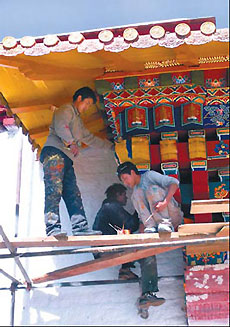
Tibet's per capita gross domestic product exceeded 12,000 yuan in 2007, almost doubling its 2002 figure, and the region's economy has, for seven consecutive years, maintained an annual growth of more than 12 percent.
That, according to Yangchen Dolkar, has much to do with outside assistance.
The four central government conferences on development issues in Tibet, in 1980, 1984, 1994 and 2001, have proved instrumental in materializing the dramatic changes in the region's economic landscape.
The 1994 meeting's idea to have other provinces, municipalities, central government offices, and major State-owned firms to team up with and assist localities in Tibet deserves particular credit for Tibet's current prosperity, says Zhang Jianjun, deputy chief of Tibet's office of one-on-one aid programs.
All the rest of the country has been involved in the high-profile aid-Tibet program.
"By the end of June 2007, domestic aid providers had financed 9.3 billion yuan on 2,861 major projects in Tibet," Zhang disclosed. "And ordinary Tibetans have witnessed tangible improvements in their lives."
Farmers' and herdsmen's per capita net income reached 2,788 yuan in 2007, 83.3 per cent up from 2002, according to Yangchen Dolkar, and 114,000 households saw improvements in housing conditions.
Tsomo's is one of them.
"We used to live in a dark and shabby flat in Xoi," says Tosmo. "We moved into a new and bigger flat in the New Xoi neighborhood in 1996."
Xoi is a centuries-old residential community at the foot of the Potala whose residents were mostly people serving the high lamas and nobles.
The New Xoi community, located not far to the northwest of the Potala Palace, features Tibetan-style buildings with modern power and flushing systems.
"Now we have an independent kitchen and a private restroom," she says with obvious content.
The 51-million-yuan new community, in addition to providing all the basic conveniences of modern urban homes and neighborhood services, includes a kindergarten and a primary school.
"If the first aid packages included more big infrastructure projects to fill blanks in basic facilities, the recent ones are increasingly titled toward upgrading qualities of life," says Yangchen Dolkar.
The autonomous region has spent 6.16 billion yuan on social undertakings since the 10th Five-Year-Plan period, more than 91 percent of which came from central finance.
Since the 10th Five-Year-Plan period, the region spent almost 3.4 billion yuan to have 2.2 million square meters of classroom space built or renovated. Across Tibet, schools often boast the best buildings in their communities.
"More than 80 percent of the new projects planned for the 11th five-year-plan period aim directly at improving living conditions, including building rural power grids, providing access to safe drinking water, and garbage and sewage treatment," says Yangchen Dolkar.
The central government has earmarked 77.8 billion yuan for 180 projects between 2006 and 2010 to improve infrastructures as well as farmers' and herdsmen's living conditions, she said.
"The kids in agricultural and pastoral areas enjoy free food and lodging and are exempted from any school fees," says Yangchen Dolkar. "Which is unthinkable in the rest of the country.
"Farmers and herdsmen in Tibet enjoy free medical care. And agricultural tax, which had not been abolished in the rest of the country until last year, has never been collected here. How much more favors can we expect from the central government?
"Every bit of change in Lhasa and elsewhere brings additional comfort and convenience to our life. And we enjoy it."
(China Daily April 29, 2008)